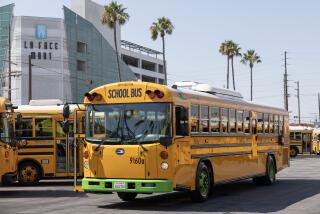Educators Ready With Needs to Fill
- Share via
With news of Gov. Pete Wilson’s plan to hand a cash grant to every school in the state came a flood of dreams Monday about what the money might buy for schools in Orange County.
The wish lists of administrators across the county covered the spectrum of needs, from patching heating ducts and repairing parking lots to touching up a new stage for a Santa Ana performing arts program. Most also dreamed of filling classrooms with more computers.
Given the state’s brightening economic picture, Wilson vowed Monday to hand all schools a grant that could be spent on almost anything that the principal, teachers and parents agree on, except salary increases. The money, expected to total more than $1 billion, would go in equal sums to every school, probably about $50,000 apiece.
While the funds don’t come close to matching the needs of the county’s poorest schools, which have suffered most in the years of state budgetary drought, the promise of unexpected resources had some administrators breathlessly composing imaginary shopping lists.
“It’s not Christmas in May,” said an astounded Jim Sieger, principal of Marco Forster Middle School in San Juan Capistrano. “This is tremendously exciting, but I want to see the money in the bank.”
Despite his reservations, Sieger had started his list, ranging from improving after-school workshops to creating some kind of appreciation program “to recognize students.”
*
Mayda Carnes, assistant principal at Santa Ana’s Sepulveda Elementary School, said her head was whirling with the possibilities of what the money could buy. Most of the 800 students there are from low-income homes and need substantial help in reading, math and technology, she said.
Although she emphasized that the school and district will confer with parents before deciding how to spend the money, Carnes said she immediately thought of resource specialists and computers as some primary needs.
“We have a lot of at-risk kids who are substantially below grade level,” she said, explaining that resource specialists could give them extra attention. “If they could get double doses of reading and math, it could help boost them to grade level.”
Teachers also long for computers in their classrooms instead of just one lab for the entire school, Carnes said. Wires and other lines are in place to hook up computer monitors, but the district has had no money to buy them.
The students also could use a curtain for their stage for visual and performing arts programs, she said.
Principal Donald K. Martin at Newport Beach’s Corona del Mar High School, which serves some of the county’s wealthiest families, said his school has avoided cuts in the budget for teachers and textbooks, but has put off some essential work on infrastructure. The entire school district needs about $15 million for deferred maintenance, he said.
Michael Hoy, principal of Richard Henry Dana Elementary School in Dana Point, said upgrading the school’s computer equipment is high on his list, since his school recently was hooked up to the Internet.
“Our teachers say they’ve gotten a freeway onramp to the information highway. Now they need a car to drive on it,” he said.
The recent upturn in financial fortune has been dizzying, he said.
“Boy, California is a roller coaster, isn’t it?” Hoy said. “We go from good times to bad times, from bankruptcy to Thanksgiving.”
Hoy said he will start figuring out how to spend the unexpected grant by polling his teachers.
“It’s been such a long, lean trip for us and teachers have been supplementing classroom budgets from their grocery budgets at home,” he said. “The first thing we’re going to do is figure out where we’re hurting and look at how much construction paper, how much lined paper do we need. Fifty thousand dollars will do a lot of things.”
Once the basics are covered, Hoy said, the school also could upgrade reading programs and foreign language instruction.
Dave Gerhard, principal of John Malcolm Elementary School in Laguna Niguel, said, “I can think of a zillion things off the top of my head. It’s so unusual to spend the money with so few stipulations on how it’s spent.”
*
Gerhard said his school first will look to nurture a science program that was started with a grant received last year. The school established an indoor earth laboratory where students take on projects such as studying fish that live near the San Onofre nuclear generating station.
The school’s dream was to someday build an outside laboratory to teach students about environmental science, he said.
“Our kids could grow cut flowers and learn about horticulture, native plants and the environment,” he said. The grant “could really help our long-range plan to support our science program.”
Times staff writer Lee Romney contributed to this report.
More to Read
Sign up for Essential California
The most important California stories and recommendations in your inbox every morning.
You may occasionally receive promotional content from the Los Angeles Times.













